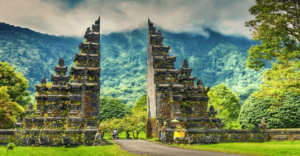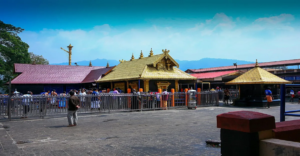Shravanabelagola is a small town located in the Hassan district of Karnataka, India. Despite its modest size, it is one of the most significant pilgrimage sites for Jains worldwide. The town is famous for its colossal statue of Lord Bahubali, also known as Gommateshwara, which stands majestically on the Vindyagiri Hill.
The town’s name, Shravanabelagola, is derived from three Kannada words: ‘Shravana’ (Saint), ‘Bela’ (White), and ‘Kola’ (Pond), referring to the large pond in the town which is surrounded by white hills. This place is a spiritual and cultural center, deeply revered by followers of Jainism.
Join Explore India Community
Historical Significance
Shravanabelagola has a rich history that dates back over two millennia. The town’s significance as a Jain center began in the 3rd century BCE when Chandragupta Maurya, the founder of the Maurya Empire, embraced Jainism and retired here, guided by his Jain guru, Bhadrabahu.
Chandragupta is said to have spent his last days meditating on the Chandragiri Hill, one of the two hills in Shravanabelagola, where his legacy is preserved through various inscriptions and monuments.
Over the centuries, Shravanabelagola flourished as a major center of Jain culture and learning. The town’s temples, inscriptions, and statues bear testimony to the patronage of various dynasties, including the Ganga, Hoysala, and Vijayanagara empires.
These rulers contributed to the construction of the town’s iconic temples and the grand statue of Bahubali, making Shravanabelagola a living museum of Jain art and architecture.
The Statue of Lord Bahubali (Gommateshwara)
The most prominent attraction of Shravanabelagola is the Gommateshwara statue, which is considered one of the largest monolithic statues in the world.
This statue stands at an impressive height of 57 feet (17.5 meters) and is carved out of a single block of granite. Erected in 981 AD by the Ganga dynasty’s minister and commander Chamundaraya, it is a symbol of peace, renunciation, and spiritual victory over earthly desires.
Architectural and Artistic Details
The Gommateshwara statue is renowned not only for its size but also for its serene and meditative expression. The statue depicts Bahubali in a standing posture of meditation known as Kayotsarga, with vines and creepers entwined around his legs, symbolizing his deep penance.
The details of the statue, including the calm expression, the finely carved hair curls, and the symmetrical proportions, showcase the high level of artistry and craftsmanship of the period.
The Mahamastakabhisheka Festival

One of the most significant events associated with Shravanabelagola is the Mahamastakabhisheka, a grand anointment ceremony of the Gommateshwara statue, which takes place once every 12 years. During this festival, the statue is bathed with various offerings, including milk, sugarcane juice, saffron paste, and precious stones, by thousands of devotees and monks.
The ritual symbolizes the washing away of worldly desires and the purification of the soul. The Mahamastakabhisheka attracts devotees from all over the world and is a spectacular event that underscores the religious and cultural importance of Shrava nabelagola.
Mahamastakabhisheka Festival
| Year | Attendees (approx.) | Significance |
| 1981 | 200,000 | First Mahamastakabhisheka after India’s independence |
| 1993 | 250,000 | Global participation increases significantly |
| 2006 | 300,000 | Attended by prominent national leaders |
| 2018 | 500,000 | Largest gathering with international media coverage |
Chandragiri and Vindyagiri Hills
Shravanabelagola is home to two sacred hills, Chandragiri and Vindyagiri, each with its own historical and spiritual significance.
Chandragiri Hill
Chandragiri Hill is the smallest of the two hills but is of immense historical importance. It is named after Chandragupta Maurya, who, according to Jain tradition, performed Sallekhana (a Jain ritual of fasting unto death) on this hill.
The hill is dotted with ancient Jain temples, known as Basadis, and memorials, including the Chandragupta Basadi, which is dedicated to Chandragupta Maurya.
The hill also houses several inscriptions in Kannada and Devanagari scripts, some of which date back to the 9th century. These inscriptions provide valuable insights into the history of the region, the reign of various kings, and the evolution of Jainism in South India.
Vindyagiri Hill

Vindyagiri Hill is the site of the magnificent Gommateshwara statue and is the focal point of pilgrimage activities in Shravanabelagola. The hill is also home to several other important Jain temples, including the Odegal Basadi and Tyagada Brahmadeva Pillar. The ascent to the top of Vindyagiri Hill involves climbing over 600 steps, a journey that is both physically demanding and spiritually fulfilling.
The hill offers breathtaking views of the surrounding landscape, including the towns of Shravanabelagola and Chandragiri Hill. For pilgrims, reaching the summit is considered an act of devotion, symbolizing the overcoming of life’s challenges.
Jain Temples and Monuments
Apart from the hills, Shravanabelagola is dotted with numerous Jain temples and monuments that are architecturally significant and spiritually enriching. These temples, known as Basadis, are characterized by their intricate carvings, detailed sculptures, and serene environments.
Jain Temples in Shravanabelagola
| Temple Name | Location | Significance |
| Chandragupta Basadi | Chandragiri Hill | Dedicated to Chandragupta Maurya, with historical inscriptions |
| Odegal Basadi | Vindyagiri Hill | Largest temple on Vindyagiri, known for its massive stone pillars |
| Akkana Basadi | Shravanabelagola town | Built in 1181 AD, dedicated to Parshvanatha, the 23rd Tirthankara |
| Chennanna Basadi | Shravanabelagola town | Notable for its ornate carvings and unique architecture |
Jain Culture and Traditions
Shravanabelagola is not just a place of worship but also a center of Jain culture and learning. The town hosts several educational institutions, libraries, and museums that preserve and promote Jain philosophy, literature, and art. The local community actively participates in preserving the traditions and customs associated with Jainism, making Shravanabelagola a living embodiment of Jain values.
The town also serves as a retreat for Jain monks and scholars who come here for study, meditation, and spiritual rejuvenation. The peaceful environment, combined with the rich cultural heritage, makes Shravanabelagola an ideal place for those seeking spiritual growth.
Accessibility and Visitor Information
Shravanabelagola is well-connected by road and rail, making it accessible to visitors from across India. The nearest major city is Bangalore, which is about 145 kilometers away. The town can be reached via private vehicles, buses, or taxis.
Best Time to Visit
The best time to visit Shravanabelagola is during the winter months, from October to March when the weather is pleasant and conducive to exploring the hills and temples. The town experiences a large influx of visitors during the Mahamastakabhisheka festival, which takes place once every 12 years.
Visitor Facilities
Shravanabelagola offers a range of facilities for pilgrims and tourists, including:
- Accommodation: Several guesthouses and hotels are catering to different budgets. Jain dharma-shalas (pilgrim rest houses) are also available for those seeking simple and affordable lodging.
- Dining: The town offers vegetarian cuisine, with several eateries serving traditional Jain food that adheres to the principles of non-violence and non-injury (Ahimsa).
- Guided Tours: Local guides are available to take visitors on tours of the temples and hills, providing insights into the history, architecture, and spiritual significance of the sites.
Join Explore India Community
Conclusion
Shravanabelagola stands as a testament to the enduring spiritual legacy of Jainism. Its towering statue of Gommateshwara, sacred hills, ancient temples, and vibrant cultural traditions make it a unique and revered destination. Whether you are a pilgrim, a history enthusiast, or a curious traveler, Shravanabelagola offers an experience that is both profound and enlightening. Visiting this ancient town is not just a journey through history but also an exploration of the timeless values of peace, renunciation, and spiritual triumph.
- 7 Day Bali Itinerary: Explore The Best Of Bali In A Week

- How to reach Mousuni Island from Kolkata?: An easy travel guide

- Sabarimala: How Many KM From Pamba To Sannidhanam?

- Top Things to Do Nearby El Nido, Palawan: Exploring Paradise Beyond the Usual

- How to Reach Sundarban From Kolkata? Most Scenic Route [2025]

- How Many Km From Pamba To Sannidhanam?

















